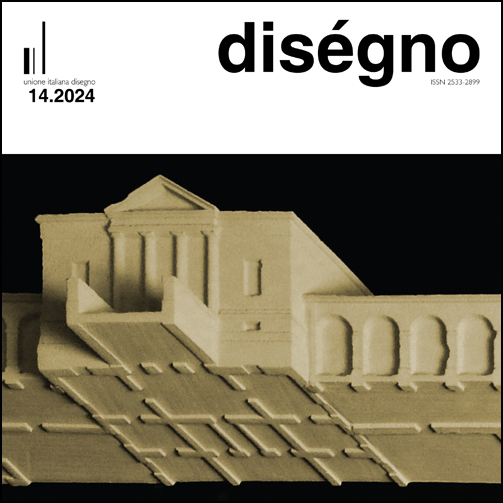Modelli “bidimensionali”. Il plastico nel progetto delle facciate architettoniche
DOI:
https://doi.org/10.26375/disegno.14.2024.19Parole chiave:
modelli di facciate, prospetti, concorsi progettazione, modello ligneo, rappresentazione rinascimentaleAbstract
A partire dal XV secolo, il modello venne utilizzato per la rappresentazione delle proposte progettuali da sottoporre al committente, presentare ai concorsi, esporre alla cittadinanza per metterla al corrente delle future trasformazioni urbane. Ritroviamo dunque, accanto ai modelli di interi edifici, plastici relativi a singole porzioni oggetto del concorso, quali cupole, dettagli architettonici, facciate. La rappresentazione tramite il modello consentiva ai committenti di esprimersi dopo una lettura critica-comparativa agevolata dalla maggiore familiarità con il reale.
L’articolo contestualizza nel periodo storico e analizza gli esempi di modello di progetto di facciate architettoniche, una tipologia particolare definita nel titolo “bidimensionale” in quanto risulta negata la possibilità di mettere in relazione la rappresentazione della facciata con la spazialità interna o comunque complessiva dell’edificio, che normalmente caratterizza il plastico. Sono tuttavia certamente classificabili come modelli, sia per i materiali impiegati, sia per la tridimensionalità degli elementi di dettaglio e i conseguenti giochi di luci e ombre che è possibile percepire, sia per la modalità di fruizione che non è vincolata ad un punto di vista unico come accade nel disegno di prospetto, e pertanto consente di mostrare la soluzione d’angolo. L’analisi è portata avanti attraverso la presentazione di esempi emblematici e il confronto con i corrispondenti disegni.
Riferimenti bibliografici
Ackerman, J. S. (1961). The architecture of Michelangelo. New York: Viking Press.
Ackerman, J. S. (2005). Introduzione. In M. Scolari, Il disegno obliquo una storia dell’antiprospettiva, pp. 9-16. Venezia: Marsilio Editori.
Alberti, L.B. (1989). De re Aedificatoria. Milano: Edizioni il Polifilo.
Aristotele (1999). La costituzione degli ateniesi. Milano: Rizzoli.
Arnheim R. (1981). La dinamica della forma architettonica. Milano: Feltrinelli.
Appian. (1972). Appian’s Roman History. With an English Translation by Horace White. London: William Heinemann Ltd. [testo orig. II sec.].
Averlino, A. (1972). Trattato di Architettura. Milano: Il Polifilo (Edition by A.M. Finoli, L. Grassi).
Bardeschi Ciulich, L. (Ed.). (2005). I Contratti di Michelangelo. Firenze: SPES.
Barocchi, P, Ristori, R. (Eds.). (1965). Michelangelo. Il Carteggio. Firenze: Sansoni.
Bevilacqua, M. (2015). I progetti per la facciata di Santa Maria del Fiore (1585-1645). Firenze: Leo S. Olschki.
Contardi, B., Curcio, G., (Eds.). (1991). In urbe architectus. Modelli, Disegni, Misure. La professione dell’architetto. Roma 1680-1750. Roma: Àrgos.
de l’Orme, P. (1567). Le Premier Tome de l’Architecture. Paris: Frédéric Morel.
de Tolnay, C. (1975). Corpus dei disegni di Michelangelo. Novara: Istituto Geografico De Agostini.
Goldthwaite, R. (1984). La costruzione della Firenze rinascimentale. Una storia economica e sociale. Bologna: Il Mulino.
Gotti, A. (1875). Vita di Michelangelo Buonarroti narrata con l’aiuto di nuovi documenti. Firenze: Tipografia della Gazzetta d’Italia.
Hirst, M. (1993). Michelangelo, i disegni. Torino: Einaudi.
Lévi-Strauss C. (2003). Il pensiero selvaggio. Alla scoperta della saggezza perduta. Milano: il Saggiatore.
Maldonado T. (1987). Questioni di similarità. In Rassegna, Maquette, n. 32, pp. 57-62.
Manetti, A. (1976). Vita di Filippo Brunelleschi. Milano: Il Polifilo. (Critical edition by D. De Robertis).
Metz, P. (1938). Die Florentiner Domfassade des Arnolfo di Cambio. In Jahrbuch der Preußischen Kunstsammlungen, Vol. 59, No 2, pp. 121-160. JSTOR, <http://www.jstor.org/stable/25170027> (accessed 10 June 2024).
Millon, H.A. (1994). I modelli architettonici nel Rinascimento. In H.A. Millon, V. Magnago Lampugnani, (Eds.). Rinascimento da Brunelleschi a Michelangelo. La rappresentazione dell’architettura, pp. 19-74. Milano: Bompiani.
Millon, H.A., Smyth, C.H. (1988). Michelangelo architetto. La facciata di San Lorenzo e la cupola di San Pietro. Milano: Olivetti.
Morrogh, A. (1994). La facciata del duomo di Firenze. In H. Millon, e V. Magnago Lampugnani (Eds.). Rinascimento da Brunelleschi a Michelangelo. La rappresentazione dell’architettura, pp. 575-585. Milano: Bompiani.
Mussolin, M. (2006). Forme in fieri. I modelli architettonici nella progettazione di Michelangelo. In C. Elam (Eds.). Michelangelo e il disegno di architettura. Firenze: Marsilio.
Opera di Santa Maria del Fiore <https://duomo.firenze.it/it/504/galleria-dei-modelli> (accessed 5 February 2024).
Pacciani R. (1987). I modelli lignei nella progettazione rinascimentale. In Rassegna, Maquette, n. 32 pp. 7-19.
Pinto J. (1991). Il modello della fontana di Trevi. In B. Contardi, G. Curcio (Eds.). In urbe architectus. Modelli Disegni Misure. La professione dell’architetto Roma 1680-1750, pp. 70-75. Roma: Àrgos.
Pomarici, F. (2004). La prima facciata di Santa Maria del Fiore: storia e interpretazione. Roma: Viella.
Schiavo, A. (1956). La fontana di trevi e le altre opere di Nicola Salvi. Roma: Istituto Poligrafico dello Stato.
Scolari, M. (2005). Il disegno obliquo una storia dell’antiprospettiva. Venezia: Marsilio.
Serlio, S. (1978). I sette libri dell’architettura. Sala Bolognese: Arnaldo Forni Editore.
Velasio, F. (1916). I Papi e l’arte in un diario romano. San Giovanni in Laterano. In Arte e Storia n. XXXV, p. 338.
Zuffanelli, G., Faglia, F. (1887). Le facciate del Duomo di Firenze dal 1298 al 1887. Firenze: Benelli e Gambi.
##submission.downloads##
Pubblicato
Come citare
Fascicolo
Sezione
Licenza
Copyright (c) 2024 diségno

TQuesto lavoro è fornito con la licenza Creative Commons Attribuzione 4.0 Internazionale.






